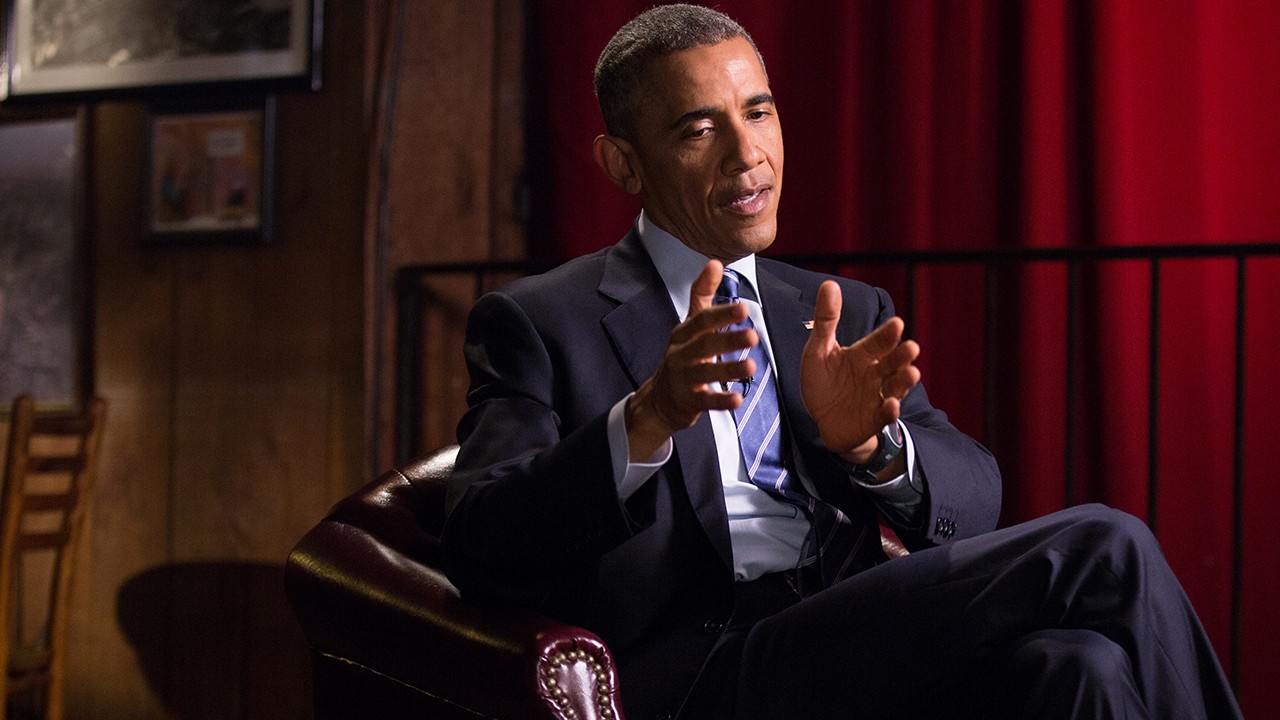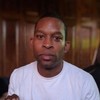Jacob Philadelphia reaches over to touch President Obama's hair.
Pete Souza: I don’t think I did. I felt it was an advantage because I always knew that what I was doing was important. And I felt comfortable being in that position. For me, pressure is having bullets flying over your head in a war zone while still trying to capture images. If anything, I actually feel some of that scrutiny now more than when I was in the White House. People are reacting really emotionally to the pictures I post on Instagram. And I feel honoured that they are.
Yeah, that’s weird. I did a book signing at the National Portrait Gallery in London and so many people kept telling me how much they love my profile. I never really expected all the attention when I started it. My only plan then was to compare the current administration to how my old boss ran things. It was really just for my own amusement. I must admit, though, I like the captions I come up with – they're playful, subtle, and I’m not being disrespectful to anyone.
Senator Obama in his office on Capitol Hill in 2005.
He was just so confident and comfortable in his own skin, and a natural in the spotlight. Jumping into the national scene in Washington didn’t seem to phase him at all. For someone who, by that point, hadn’t received a lot of close media attention, it was really unusual how relaxed he was around me taking his picture all day. In my 30 years of photographing congressman, senators and presidents, I don’t think I’ve ever seen someone so inexperienced be so at ease in the spotlight.How has he changed in the past 12 years?
His core character hasn’t changed at all, but the demands on him did, and you could always sense the burden of the job weighing on his shoulders. However, when I saw him a couple of weeks ago it was clear that that weight had completely gone – he was so much more relaxed.
Barack and Michelle Obama heading up to one of the many inaugural balls in 2009.
It became easier over time as we grew more comfortable being around each other every single day. But importantly, he always understood the value and importance of documenting his presidency for history, so he always respected me and the work I was doing.The origin story of the majority of the millennials who filled Obama-land involved little more than graduating from college and volunteering on his campaign. But you'd already worked as a photographer in the Reagan administration. What did that experience give you?
It meant that by the time I started in the Obama White House, I wasn’t fazed by being around and working with powerful men and women while they were making powerful decisions. They never intimidated me because I knew I belonged there, and I knew what I was doing was important. I'm not sure I would've been that confident if I didn't have that previous experience.Also, I knew exactly how the job needed to be done. I knew that in order to create the best photographic archive I needed to have access to everything, and because I had already established a personal relationship with President Obama, I was able to ask for and be granted access to everything.
WATCH: President Obama Speaks with VICE News

Your job required you to be extremely present, but invisible amid the chaos of a presidency – taking care to never affect the scene you were capturing. How difficult was that?
It wasn’t hard at all. I knew what my role was, which was not to be a participant, but an observer with a camera – a place that I’m entirely comfortable with. I actually relished being around the chaos. During a crisis, I felt like I was really documenting history. I always felt that some of my best pictures came from those situations, because it showed the president really trying to solve a problem, and I had to buckle down to make sure I was capturing what was taking place in the right way.
That’s so hard to articulate. For me, I’ve always had a good sense of what’s really going on. I would feel it, and then wait for that one moment that best expressed the mood and atmosphere. For example, the day that Congress passed the Affordable Care Act, I was just waiting for the second that showed his real sense of satisfaction that he had accomplished something big. It's important to be patient because one picture can easily misinterpret a scene.
Obama playing in the Oval Office with the daughter of an aide on Halloween, 2005.
What I saw more than anybody else were all the different compartments of his life, and the way he balanced being the busiest man on the planet with being a husband and father. I saw that struggle better than anybody else. For me, that’s what’s special about being a White House photographer.It’s incredible how he did it. So many times he would be in a middle of a stressful day and he would see his daughter Malia out on the swings and he would walk outside and spend ten minutes with her, completely forgetting what was on his mind, and be all-in with her. He just had the ability to do that. He told me many times that he didn’t get a lot of sleep every night, but he would fall asleep right away. And I don’t know how he did that, because he must've had so much on his mind, but he had this innate ability to switch off.
The Obamas dance to Earth, Wind and Fire at the 2010 Governor's Ball.
My main focus was on making authentic pictures. Traditionally, the job involves just showing the president at work, but I wanted to be different. And I think that’s where the honesty and authenticity comes from. And I appreciate the fact that, in his forward, President Obama says that I was always able to get the right mood.But when two people spend that much time together in a high pressured environment it can go very wrong. How were you able to develop that close personal relationship?
It was the sheer number of hours we spent right in each other's space that, at the very least, got us to the point where we understood the other better. And though he’s younger than me, we come from more or less the same generation, and so there's something unique we shared because of that. We could talk about movies and TV shows from when we were growing up that the younger staffers at the White House had no clue about.Most importantly, I think we shared the same values. The decisions he was making for the country were the kind of decisions that I wanted him to make as a citizen. I think, as a White House photographer, you have to respect the person who’s president. I respected Ronald Reagan. I didn’t agree with all of his decisions, but I respected him. That’s the one characteristic that I think a White House photographer has to have.
No.
Obama coaching his daughter Sasha's basketball team in 2011.
I knew something was going down about a week before, but I didn’t know the details. I was just told that something was happening on either the following Saturday or Sunday, which I knew meant a special ops mission, because they normally reserve a backup date in case of bad weather. On the day itself, it wasn’t until about four or five hours before the raid was launched that I knew we were going after bin Laden.We all packed into this tiny conference room for about 40 minutes to monitor the situation. It was strangely silent the entire time because the most powerful people in our government were just watching and couldn’t affect what was happening; it was all up to the guys on the ground.I shot about 100 pictures in that time, which, if you think about it, is not a lot. I was just trying to click at the right moments, without disturbing what was going on. Hopefully from my photo you can sense the tension in the room. Nobody knew if bin Laden was even in the house, let alone what the outcome would be.
Monitoring the mission to kill or capture Osama bin Laden in the White House Situation Room in May, 2011.
Honestly, I don't have a favourite.Then what were your favourite moments?
Well, photographing him as a father, I would say. The day of the big snowstorm in Washington. That's a day I’ll never forget. With the White House in the background, I was able to capture some great moments of him playing in the snow with his girls, which I’m very proud of. That was pretty special.
The Obamas playing outside the White House during a snowstorm in 2010.
Exactly. I think that moment said, "Here’s a four-year old African-American kid touching the head of the President of the United States who looked just like him." That’s what resonated with most people. But it also says something about the president who, at the behest of a child, bent over and let this kid touch his head.When I was working on the book and trying to decide which picture to put on the back cover, I posted four options on Instagram for people to vote on. And just a couple of days later, I had an eight-year-old African-American boy run up to me and tell me that he and his mum had seen my post and voted. And when I asked him which one he voted for, he just pointed to his own hair. He didn’t even say anything, and he didn’t need to. And that just tugged at my heart. Here’s this young kid who identified with Jacob, and the feeling of pride he had because he thought the president looked like him. There were so many moments like that, and I was honoured to capture them all. Obama: An Intimate Portrait is out now on Penguin Books.
Three-year-old Clark Reynolds meeting Obama.
Listening to Thelma "Maxine" Pippen McNair in the Oval Office in 2013. Thelma's daughter, Denis, was one of four young girls killed in a racist attack on the Sixteenth Street Baptist Church in Alabama in 1963.
Meeting Prince George at Kensington Palace in 2016.
Working from the Resolute Desk in October, 2016.
Obama giving a speech in Accra, Ghana in 2009.
